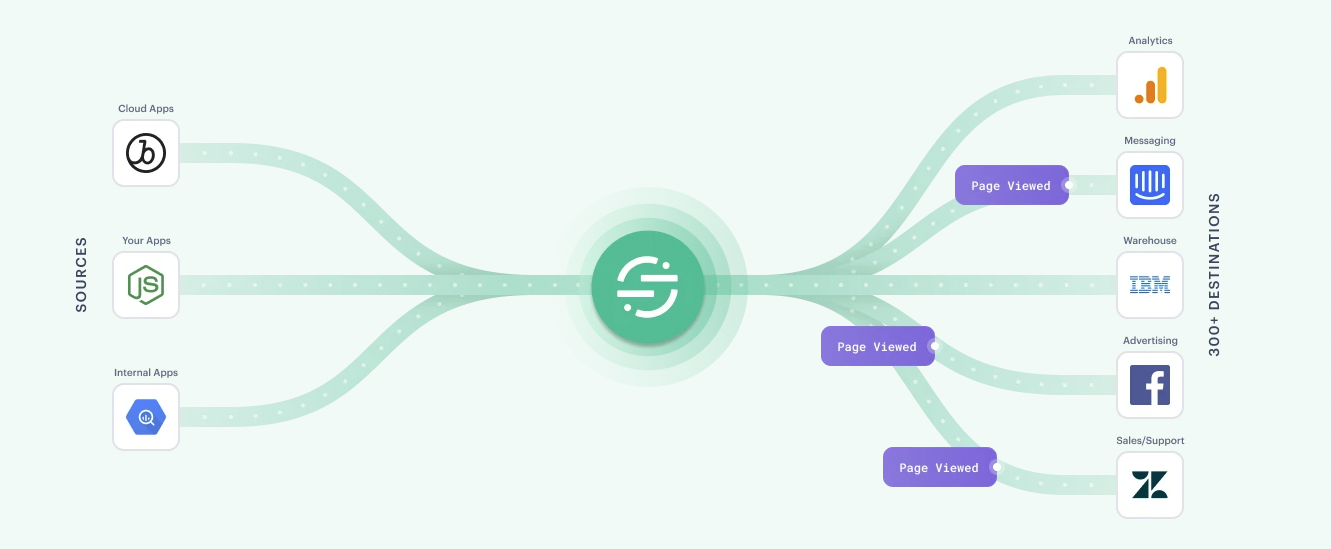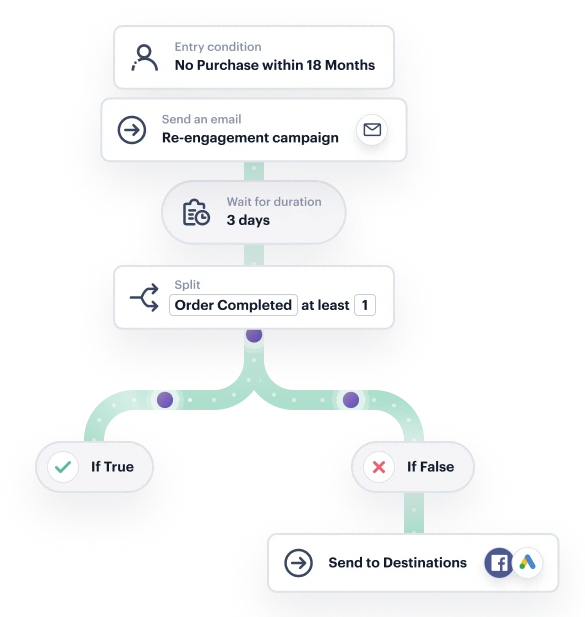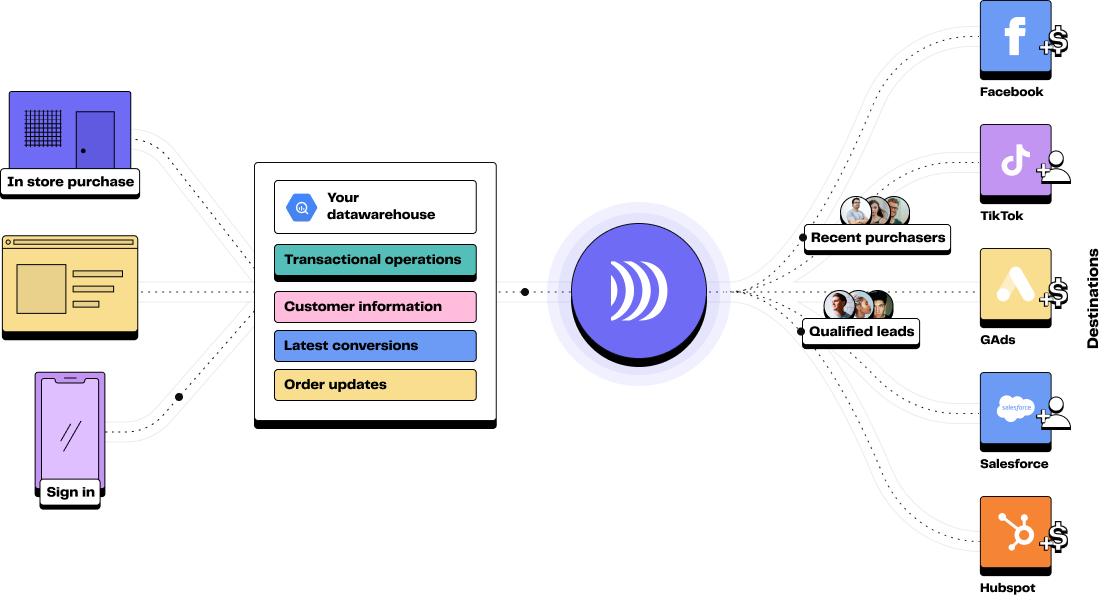Founded in 2011, Segment stands as one of the oldest Customer Data Platforms (CDP) in today’s market. It facilitates the collection of customer data from various sources, whether they be websites, applications, or servers, and then transfers this data to an array of marketing destinations and analytics tools.
While Segment now encompasses the full spectrum of CDP functionalities, its initial renown stemmed from event tracking, particularly following the launch of SDKs that businesses could implement on their websites to gauge customer behaviour. Over the years, Segment enriched its platform by integrating additional features and tools, thereby evolving into a comprehensive Customer Data Platform.
💡 Should you be implementing Segment in the upcoming months, our detailed guide is at your disposal. This comprehensive guide presents the key features of Segment and also compares various CDP alternatives that are presently available in the market, including those with better pricing and platform offerings.
What is Segment?
A brief history of Segment
Fun fact: the founders* initially embarked on developing a feedback application intended for teachers. However, they pivoted towards creating a customer data management solution upon recognising the difficulties businesses faced in managing and integrating customer data from numerous sources to several destinations. This shift enabled companies to gain valuable insights from their user data.
The company experienced rapid growth and attracted investor attention, raising several million dollars over the years. In 2020, Segment was acquired by Twilio, a cloud communications company, for approximately $3.2 billion.
Before Segment's acquisition by Twilio in 2020, Segment was primarily aimed at developers and software engineers to avoid the need to build and maintain APIs and data pipelines for data collection and activation.
Today, Segment is targeting marketing managers. The american vendor offers a complete CDP that enables businesses to gather, unify and route customer data from various sources to various tools and applications. Twilio / Segment now covers all CDP use cases.
How does Segment work?
Segment offers a wide range of features but has four core products: Connections, Protocols, Unify, and Twilio Engage. These tools collectively assist in comprehensive data management and marketing automation.
1️⃣ Connections: Segment's core offering, this feature allows the collection of events from various sources (applications, servers, websites, etc.) and stores them. This service then sets up the sending of gathered customer data to several hundred destinations like advertising platforms, analytics tools, CRMs, and more, all through a user-friendly no-code interface.

2️⃣ Protocols: This product defines how customer data should be collected and stored in Segment to meet business requirements. Segment offers APIs, SDKs, and other ingestion methods to track all events.
3️⃣ Unify: This tool enables Segment to formulate complete customer profiles from behavioural data gathered across multiple touchpoints through a process known as deterministic identity resolution.
4️⃣ Twilio Engage: Emphasising Segment's capabilities in audience creation and customer engagement, this feature allows forming audiences based on specific events or attributes. These audiences are then transmitted to downstream tools to foster personalisation, better insights, and augment marketing performance.
Moreover, Twilio Engage offers the orchestration of customer journeys with an intuitive interface and standard templates for a quick start, such as abandoned cart follow-ups, re-engagement strategies, and more.

What are the alternatives to Segment?
Alternative #1: Composable CDPs
Definition of Composable CDPs
Traditional CDPs, like Segment, come with several drawbacks:
Rigidity of data models: Traditional CDPs impose predefined data models (“customers”, “transactions”, etc.) that may not match the structure of a company.
Data security: Data is stored in vendor-owned databases, raising security and data privacy concerns.
Data duplication: Using a traditional CDP leads to data duplication if the company already has a centralised database (like a data warehouse). This can result in discrepancies between data sources, contradicting the “single source of truth” principle, and raising data quality issues.
High costs: The license price for traditional CDPs is often very high. Additionally, setting up and maintaining these platforms can be expensive, requiring significant financial and human resources.
With the emergence of cloud solutions, a new approach to CDPs is emerging: Composable CDPs.
A Composable CDP is a modular solution that collects, models, and activates customer data from your existing data infrastructure. It leverages the customer data repository of a data warehouse. Rather than functioning as a separate entity, the Composable CDP integrates seamlessly into your Modern Data Stack, addressing all the disadvantages of traditional CDPs while covering the same use cases.

Traditional vs. Composable CDP: what's the difference?
Our One Pager on the functional and architectural differences between a traditional CDP and a Composable CDP.
💡 Note that Segment is accelerating its development of connectors to data warehouses (aware of the issue, but less mature on the subject). A trend that confirms the growing interest in the composable approach.
Competitive advantages of DinMo
DinMo's main advantages over Segment are its native data warehouse approach, greater flexibility for the data model, better data control, marketing-first approach, and pricing structure.
Indeed, DinMo allows building your own Customer Data Platform directly from your data infrastructure, rather than relying on Segment's proprietary database. This eliminates the solution lock-in, reduces costs, and ensures full data ownership. With its native data warehouse architecture, DinMo adds more value to existing infrastructure investments by data teams.
Nevertheless, DinMo not only meets the needs of data teams but also provides business teams with a tool they can perfectly use without requiring an engineer. We are not just a Reverse ETL tool but a complete platform for data activation.

All data can be stocked in the data warehouse
DinMo was conceived from the start as the component bridging the gap between marketing and data. Validated by data teams, our solution allows digital and marketing teams to activate all their data across all channels, all autonomously! Tests, experiments, enrichments… for acquisition, CRM, support, personalisation, everything becomes possible with a few clicks. DinMo’s platform offers extensive support for marketers and better engagement strategies.
For companies concerned about data security and compliance, DinMo stands out with its “data warehouse native” approach. It never stores customer data, ensuring immediate CCPA and GDPR compliance.
If you want to find out more, download our full comparison below!

Key differences between Segment and DinMo
In the rest of this article, we'll look at Segment's other competitors in other categories:
Other traditional CDPs: the closest alternatives in terms of architecture, on the market since the 2010s
Infrastructure solutions, also known as CDP Infrastructure: alternatives for data teams

Categories of CDP
Other traditional CDPs
mParticle
mParticle is a well-established CDP, primarily focusing on mobile event collection. With a strong emphasis on large enterprises, mParticle encompasses all the essential features of a CDP: data collection, storage, audience management, personalisation, and even real-time scenarios along with predictive attributes, courtesy of its “Cortex” product. These features set the stage for optimal marketing campaigns and user engagement.
The platform was initially developed by its founders as an alternative for Segment, proffering more security, flexibility, and superior support. mParticle was also one of the first CDP players to introduce audience building functionalities (Segment Personas).
The two solutions bear close resemblance, yet mParticle is known for its more powerful capabilities. Both solutions cater to a technical audience, thereby necessitating some degree of acumen for marketing teams.
An additional advantage of mParticle lies in its extensive real-time data routing capabilities, which sets it apart in various contexts.
Tealium
Tealium was initially a Tag Management System solution and thus one of the main competitors of Google Tag Manager. Over the years, Tealium has broadened its toolset to encapsulate real-time data collection, management, storage, and real-time activation features.
These products help businesses collect, unify, and activate their customer data across different touch points, providing a complete view of the customer journey. Tealium’s solutions aim to improve customer experience, increase operational efficiency, and achieve better marketing results.
In general, Tealium offers a more extensive suite of tools for analytics and data management, with a strong emphasis on real-time data processing and activation.
On the whole, Tealium offers a more comprehensive suite of analytics and data management tools, with a marked emphasis on real-time data processing and activation. Its features cater better to those requiring immediate customer data insights.
Tealium is also more robust in terms of data security (features, regulatory compliance, contractual policies, etc.) and is therefore more widely favored by financial services or healthcare companies.
Lytics
Lytics is a steadfast traditional CDP, renowned for its advanced audience segmentation functionalities and the ease it brings in delivering personalised content. A primary competitive edge of Lytics is its AI-powered features that enable businesses to gain deeper insights into customer behaviour and curate personalised experiences for each user. Notably, its machine learning (ML) and artificial intelligence (AI) capabilities are among the best in the industry.
Lytics now offers direct integration with Google’s cloud environment (GCP), moving towards the Composable CDP model. The company was acquired by Contentstack in January 2025 to develop their Digital Experience Platform (DXP).
ActionIQ
ActionIQ is initially a traditional CDP, very similar to Segment or mParticle. However, with the growing demand for composable approaches (“data warehouse first”), ActionIQ has rethought its architecture to better integrate with data warehouses. Today, ActionIQ positions itself as a “hybrid” solution, allowing for storage with the vendor or directly in a data warehouse.
By offering this alternative, ActionIQ has also revised its data model, making it more flexible than Segment’s (though it still requires a Solution Engineer from ActionIQ).
⚠️ Note, however, that the “data warehouse” integration is more recent and thus less mature.
Aside from this notable structural difference, Segment and ActionIQ offer very similar features and are quite equivalent in terms of performance.
Infrastructure solutions
Treasure Data
Treasure Data did not start as a CDP; it was initially founded in 2011 as a Big Data platform. After observing a trend where the majority of its use cases revolved around marketing teams, Treasure Data transitioned into the CDP space. Subsequently, functions around unification, segmentation, and audience activation were developed to cater to its newfound audience.
Despite this transition, Treasure Data remains a rather technical solution for data management, often necessitating advanced data engineering expertise for both implementation and maintenance. While it indeed checks all the boxes of a CDP, it is more suited for roles centered around data, making it less accessible for marketing professionals.
That said, Treasure Data offers more advanced features than Segment in complex and large data environments, with advanced analytics and Machine Learning applications.
RudderStack
RudderStack was originally founded as an open-source alternative to Segment, which data teams could easily implement to collect behavioural data.
RudderStack offers an infrastructure dedicated to the collection, processing, and storage of customer data through its various products: event streaming, ETL, identity stitching, Reverse ETL, and Audience Builder. It broadly covers the same use cases as Segment.
Its mission is to help data teams build and maintain a Customer Data Infrastructure (CDI) rather than handling functions tailored to marketers’ needs, which is typically expected from a CDP. While RudderStack can be used for typical CDP use cases, marketing teams might find it challenging to use autonomously.
CRM suites
Aware of the growing Customer Data Platform market, more and more players (CRM, marketing automation solutions, etc.) are attempting to commercialise a CDP component.
These components are less mature and generally offer fewer features than traditional CDP players. However, they offer the possibility of a quick return on investment, with short implementation times and the ability to deploy the first use cases within a few weeks.
Two major drawbacks to these solutions:
They are generally less performant in terms of data security and governance.
They do not offer a standalone solution and require keeping the underlying solution for CRM, marketing automation, etc. Changing tools necessarily involves changing CDP, which could mean a long project ahead (selecting and migrating the CRM + CDP solution, for example).
The CDP suites from major players (e.g., Salesforce) are satisfactory in their environment but lack connectors with third-party destinations.
👉🏼 Feel free to check out our comprehensive article on CDP vendors to learn about other players and find out more about this topic.
If you want to learn more about our solution, feel free to contact us!
*Calvin French‑Owen, Peter Reinhardt, Ilya Volodarsky, Ian Taylor


















